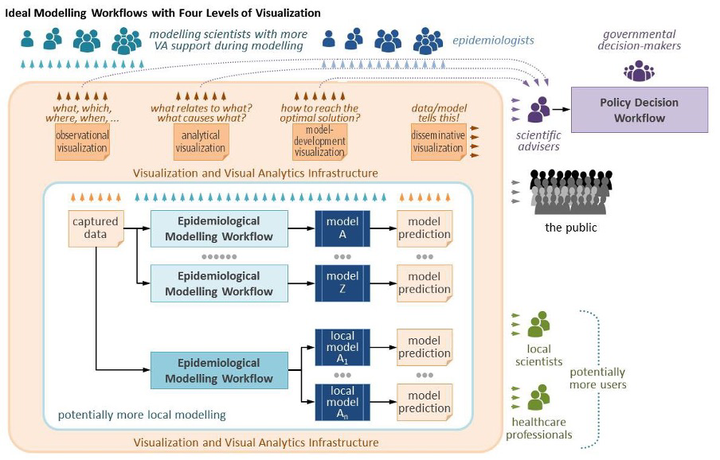RAMP VIS
Making Visual Analytics an Integral Part of the Technological Infrastructure for Combating COVID-19

Computational modelling of the COVID-19 pandemic has been playing a significant role in the UK’s effort to combat COVID-19. Across the country, there are about 100 research teams working on different models, and several dozens have provided simulation, estimation, and prediction to inform the governmental decisions in the four home nations. One noticeable oversight is the under-utilisation of visualization and visual analytics technology in supporting the scientific workflows for model development, which typically consists of a set of iterative processes, such as (a) hypothesis formulation and causality analysis; (b) model development, testing, validation, and comparison; (c) model deployment, monitoring, and improvement; and (d) scientific and public dissemination.
Because visualization is widely mistaken only for information or knowledge dissemination, the technology is commonly underused in all other stages of a modelling workflow. Ideally, modelling scientists and epidemiologists could have a quick glance of dynamic data anytime there is a need (cf. stock brokers observing stock market data), access effective overviews of spatiotemporal patterns of the disease development and control (cf., meteorologists observing satellite images, contour maps, etc.), be provided with external memorization of data to stimulate hypotheses and contemplate various decisions (cf. a general pacing around in a war room in front of many maps), and receive advice from an ensemble of analytical algorithms and visualizations about similarity, anomalies, clusters, correlation, causality, and association hidden in the data (cf. a CEO consulting specialists). Ideally, there is a visual analytics infrastructure, as a “standing capacity” (Secretary of State), that can support many modelling teams performing daily observational, analytical, and model-developmental tasks.
The proposed VA technical and knowledge infrastructures are essential for combating COVID-19 pandemic, as many epidemiologists are preparing for COVID-19 to be a threat for some time. With the recent introduction of localised control measures, it indicates an additional need for localised VA supports for many local scientists and healthcare professionals. When vaccination starts, there is a need for monitoring and modelling the effectiveness of different vaccines used in different regions. Such a nationwide need can be cost-effectively delivered by the VA technical and knowledge infrastructures.
For more information, see the RAMP-VIS website.